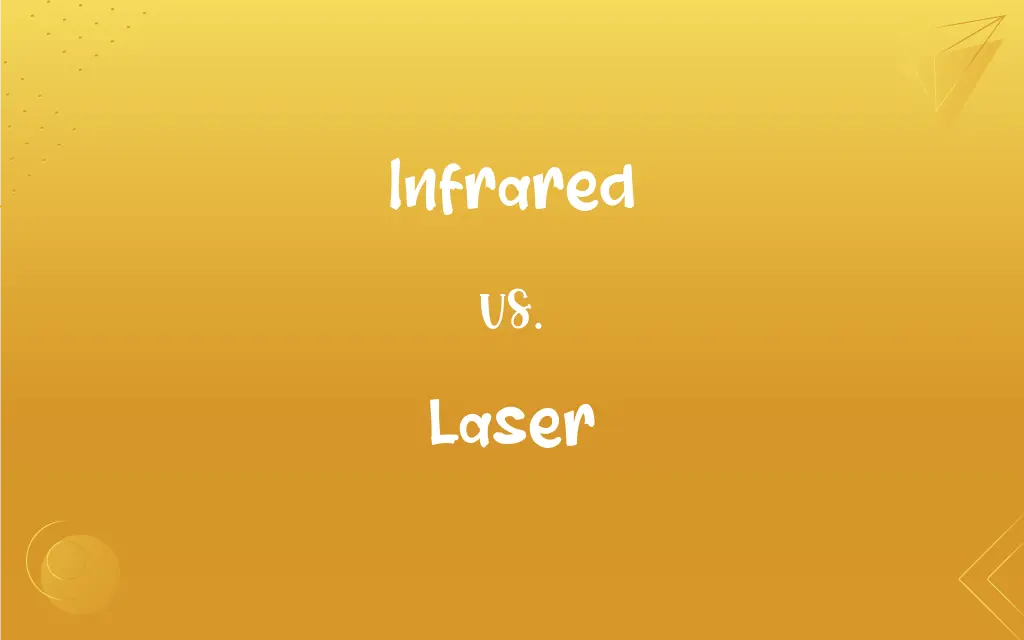Infrared vs. Laser: What's the Difference?
Edited by Harlon Moss || By Janet White || Published on October 21, 2023
"Infrared" refers to electromagnetic radiation with wavelengths longer than visible light, while "Laser" is a device emitting intense light through optical amplification.

Key Differences
"Infrared" and "Laser" are terms that both relate to light, but they represent different concepts. Infrared is a type of electromagnetic radiation, part of the electromagnetic spectrum, that has wavelengths longer than those of visible light but shorter than microwaves. It's the radiation we feel as heat and use in devices like remote controls. Conversely, a Laser is not a type of radiation but a device or mechanism. The term "Laser" stands for Light Amplification by Stimulated Emission of Radiation. It emits light through a process of optical amplification, producing a narrow and focused beam.
It's interesting to note that while Infrared is a category of light wavelengths, lasers can be designed to emit various kinds of light, including infrared. This means that there can be infrared lasers. Such lasers emit light in the infrared spectrum and are used in various applications, including communication, medical procedures, and military technology. The primary difference, in this context, is that Infrared describes a range of light, while Laser describes a mechanism for producing specific types of light.
In everyday use, we often encounter Infrared in heating and wireless communication. For example, many remote controls for electronics use infrared signals to communicate with devices. Lasers, on the other hand, have a wide range of applications, from reading barcodes at the supermarket to performing intricate surgeries. Their ability to focus light into a narrow beam makes them ideal for precision tasks.
Another distinguishing factor is the way humans perceive them. Infrared, being beyond the visible spectrum, is not visible to the human eye. We can't see it, but we can feel it as heat. Lasers, depending on their design, can emit visible or invisible light. A red laser pointer emits light in the visible spectrum, while an infrared laser, as mentioned earlier, would be invisible to us. Both, however, have significant impacts on technology and our daily lives.
Comparison Chart
Definition
Electromagnetic radiation with wavelengths longer than visible light.
Device emitting light through optical amplification.
ADVERTISEMENT
Nature
Type of light wavelength.
Mechanism or device.
Visibility
Invisible to the human eye.
Can be visible or invisible, depending on design.
Common Use
Heating, remote controls, thermal imaging.
Reading barcodes, surgeries, communication, entertainment.
Representation
Part of the electromagnetic spectrum.
Device producing focused light beams.
Infrared and Laser Definitions
Infrared
The part of the electromagnetic spectrum with wavelengths longer than visible light.
Infrared wavelengths are commonly used in remote controls.
ADVERTISEMENT
Laser
Light Amplification by Stimulated Emission of Radiation.
A laser pointer is a popular tool for presentations.
Infrared
Radiation felt as heat but not seen.
The sun emits a significant amount of infrared radiation.
Laser
A mechanism producing intense, concentrated beams of light.
Lasers are used in medical surgeries for their precision.
Infrared
Electromagnetic radiation beyond the red end of the visible light spectrum.
Infrared cameras can detect heat emitted by objects.
Laser
A device emitting focused light through optical amplification.
Scientists use lasers for precision experiments.
Infrared
Light waves used in various technologies, from communication to heating.
Infrared saunas use infrared light to produce heat.
Laser
A technology producing light beams for various applications.
Laser shows are popular at music concerts.
Infrared
A type of light that's invisible but detectable by its heat.
Infrared sensors can detect movement in the dark.
Laser
A device emitting monochromatic, coherent light.
The barcode scanner uses a laser to read codes.
Infrared
Of or relating to electromagnetic radiation between microwaves and red visible light in the electromagnetic spectrum, having frequencies between 300 gigahertz and 400 terahertz and wavelengths between 1 millimeter and 750 nanometers.
Laser
Any of several devices that emit highly amplified and coherent radiation of one or more discrete wavelengths. One of the most common lasers makes use of atoms in a metastable energy state, which, as they decay to a lower energy level, stimulate others to decay, resulting in a cascade of emitted radiation.
Infrared
Generating, using, or sensitive to infrared radiation.
Laser
A beam of radiation emitted by a laser.
Infrared
Infrared light or the infrared part of the spectrum.
Laser
(Sports)A ball or puck sent in a straight line at high speed
Shot a laser into the upper right corner of the goal.
Infrared
(uncountable) The electromagnetic radiation of a wavelength longer than visible light, but shorter than microwave radiation, having a wavelength between 700 nm and 1 mm.
Electromagnetic radiation
Laser
A device that produces a monochromatic, coherent beam of light.
Infrared
(countable) A specific wavelength in this range.
Laser
A beam of light produced by such a device; a laser beam.
Infrared
(countable) A device that emits infrared radiation.
Laser
A laser printer.
Infrared
Having a wavelength in the infrared spectrum.
Laser
A gum resin obtained from certain umbelliferous plants.
Infrared
Lying outside the visible spectrum at its red end; - said of rays having a longer wavelength (and thus less refrangible) than the extreme red rays, specifically those electromagnetic waves having a wavelength of between 700 nanometers and 1 millimeter.
Laser
Such a plant.
Infrared
Relating to, using, or producing infrared radiation.
Laser
To cut with a laser.
Infrared
Affected by infrared radiation; as, infrared detector; infrared film.
Laser
(sports) To throw or kick with laser-like precision.
Infrared
The infrared part of the electromagnetic spectrum; electromagnetic wave frequencies below the visible range;
They could sense radiation in the infrared
Laser
A device which produces an intense, usually narrow, monochromatic beam of coherent light; called also optical maser. It has various forms, and is used in various applications in science and technology. The beam is produced by boosting the majority of the electrons in specific radiation-absorbing atoms in a medium into a higher energy level, from which they are stimulated by their own emitted radiation to drop back synchronously to their lower energy level, and emit light which is in phase (coherent).
Infrared
Electromagnetic radiation with wavelengths longer than visible light but shorter than radio waves
Laser
An acronym for light amplification by stimulated emission of radiation; an optical device that produces an intense monochromatic beam of coherent light
Infrared
Having or employing wavelengths longer than light but shorter than radio waves; lying outside the visible spectrum at its red end;
Infrared radiation
Infrared photography
FAQs
What's a common use for infrared?
Infrared is commonly used in remote controls for devices.
Can lasers emit infrared light?
Yes, there are lasers designed to emit infrared light.
What is a practical application of lasers in medicine?
Lasers are used in eye surgeries and for removing tumors.
How does infrared imaging work?
It detects infrared radiation (heat) emitted by objects and translates it into visible images.
Can infrared be harmful?
In high concentrations or prolonged exposure, infrared can cause burns or other injuries.
Is infrared a type of laser?
No, infrared is a type of light wavelength, while a laser is a device that can emit light, including infrared.
Are lasers always visible?
No, lasers can emit both visible and invisible light, depending on their design.
How do CD players use lasers?
CD players use lasers to read the information encoded on the disc.
Is infrared used in communication?
Yes, infrared is used in wireless communication, such as in some Wi-Fi setups.
What does the term "laser" stand for?
Laser stands for Light Amplification by Stimulated Emission of Radiation.
What are lasers made of?
Lasers consist of a gain medium, an energy source, and two mirrors forming an optical cavity.
Can we feel infrared?
Yes, we feel infrared as heat.
Why can't we see infrared?
Infrared has wavelengths longer than visible light, making it invisible to the human eye.
Are lasers safe?
When used properly, lasers are safe, but direct exposure can be harmful, especially to the eyes.
What's the difference between infrared and ultraviolet?
Infrared has longer wavelengths than visible light, while ultraviolet has shorter wavelengths.
How do lasers work in printers?
Lasers in printers create an electrostatic image on a drum, which then transfers toner to paper.
Are lasers used in military applications?
Yes, lasers are used for targeting, communication, and even as potential weapons.
Why are lasers coherent light sources?
Lasers emit light that is of one frequency and phase, making it coherent.
Can animals see infrared?
Some animals, like certain snakes, can detect infrared radiation.
Are infrared heaters efficient?
Yes, infrared heaters can be very efficient as they directly heat objects and people.
About Author
Written by
Janet WhiteJanet White has been an esteemed writer and blogger for Difference Wiki. Holding a Master's degree in Science and Medical Journalism from the prestigious Boston University, she has consistently demonstrated her expertise and passion for her field. When she's not immersed in her work, Janet relishes her time exercising, delving into a good book, and cherishing moments with friends and family.
Edited by
Harlon MossHarlon is a seasoned quality moderator and accomplished content writer for Difference Wiki. An alumnus of the prestigious University of California, he earned his degree in Computer Science. Leveraging his academic background, Harlon brings a meticulous and informed perspective to his work, ensuring content accuracy and excellence.






































































